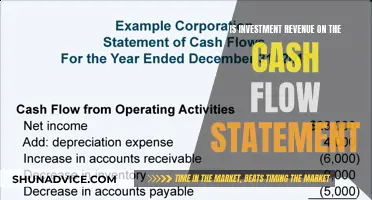
Investing during retirement is a crucial topic, as longer life expectancies mean that retirement savings may need to last 20 years or more. A retiree's investment approach should balance growth and income to meet their spending needs and sustain their portfolio over the long run. This involves determining an appropriate asset mix of stocks, bonds, and cash investments that suit the individual's timeline and risk tolerance. Here are some strategies and options for retirees to consider when investing their cash.
| Characteristics | Values |
|---|---|
| Investment type | Annuities, bonds, income-producing equities, high-yield savings accounts, certificates of deposit, dividend-paying blue-chip stocks, real estate investment trusts, stable value funds, index funds, treasury securities, agency bonds |
| Risk | Low-risk investments are preferable for retirees, but risk tolerance varies from person to person. |
| Returns | High-return investments are ideal, but returns should be balanced with risk. |
| Accessibility | Keep some money accessible in high-yield savings accounts for short-term expenses. |
| Diversification | Diversification is important to maintain a stable portfolio. |
| Professional advice | It is recommended to consult a financial professional or advisor to determine the best investment strategy for your circumstances. |
What You'll Learn

High-yield savings accounts
When choosing a high-yield savings account, consider the annual percentage yield (APY), minimum opening deposit, minimum balance requirements, and monthly maintenance fees. Some accounts may also have restrictions on the number of withdrawals you can make each month. It is also important to note that high-yield savings accounts have variable APYs, which means the interest rate is subject to change at the bank's discretion.
- LendingClub Bank: No minimum opening deposit or monthly service fees. Offers a competitive APY on its LevelUp account if you deposit at least $250 per month.
- BrioDirect: Requires a minimum opening deposit of $5,000 and a minimum balance of $25 to earn the APY.
- EverBank: No minimum opening deposit or monthly maintenance fee. Offers a competitive APY.
- Bread Savings: Requires a minimum opening deposit of $100 and no monthly maintenance fees. Charges a $5 fee for paper statements and $25 for wire transfers.
- CIT Bank: Offers two types of savings accounts. The Platinum Savings account requires a minimum balance of $5,000 to earn a competitive APY, while the Savings Connect account can be opened with just $100. No monthly service fees for both accounts.
- Bask Bank: No minimum opening deposit or monthly service fee. Offers a competitive APY on its Bask Interest Savings account. Charges $35 for outgoing wire transfers.
- Popular Direct: Requires a minimum opening deposit of $100 and charges a $25 fee if the account is closed within the first 180 days. Offers a competitive APY and has no monthly maintenance fee.
- CIBC Bank USA: Requires a minimum opening deposit of $1,000. No monthly service fee. Offers a competitive APY on its Agility Online Savings Account.
- TAB Bank: No minimum opening deposit or monthly service fee. Offers a competitive APY on its High Yield Savings Account. Charges $5 for paper statements and $30 for outgoing wire transfers.
- UFB Direct: No minimum opening deposit or monthly service fee for the UFB Portfolio Savings account. Offers a competitive APY and has ATM access.
Cashing Out on Robinhood: A Guide to Withdrawing Your Investments
You may want to see also

Short-term bonds
Short-term bond funds are mutual funds and exchange-traded funds (ETFs) that typically invest in government and corporate bonds with maturities of less than five years. Bonds with shorter times to maturity are less sensitive to changes in interest rates than longer-term bonds, meaning investors are protected from the full impact of rising rates. As interest rates and bond prices move in opposite directions, short-term bonds are a safer option when rates are expected to rise as investors will not suffer as much if rates head higher.
Short-term bond funds can make sense for many different investors but are particularly well-suited for those saving towards short-term goals. Money that you think you will need in the next three to five years can be invested in short-term bonds, allowing you to earn a decent rate of return without taking on too much risk.
When considering a short-term bond fund, pay special attention to the fund's expense ratio, or fee. All else being equal, a lower expense ratio is better. Here are some of the best short-term bond funds to consider for your portfolio:
- SPDR Portfolio Short-Term Corporate Bond ETF: Tracks the performance of the Bloomberg U.S. 1-3 Year Corporate Bond Index. Offers exposure to U.S. corporate bonds with maturities between one and three years. SEC yield: 4.48%. Expense ratio: 0.04%.
- IShares 1-5 Year Investment Grade Corporate Bond ETF: Tracks the performance of an investment-grade corporate bond index with maturities between one and five years. Holdings include bonds issued by Bank of America, Wells Fargo, and Microsoft. SEC yield: 4.60%. Expense ratio: 0.04%.
- Schwab 1-5 Year Corporate Bond ETF: Tracks the total return of an index measuring the performance of the short-term U.S. corporate bond market. Holds corporate bonds with remaining maturities between one and five years. SEC yield: 4.47%. Expense ratio: 0.03%.
- Vanguard Short-Term Bond ETF: Tracks the performance of a market-weighted bond index made up of investment-grade bonds with a dollar-weighted average maturity of 1-5 years. Holds government bonds, high-quality corporate bonds, and investment-grade international dollar-denominated bonds. SEC yield: 4.11%. Expense ratio: 0.04%.
- Fidelity Short-Term Bond Fund: Aims to produce a high level of current income while preserving capital. Typically invests at least 80% of its assets in all types of investment-grade debt and maintains a dollar-weighted average maturity of three years or less. SEC yield: 4.39%. Expense ratio: 0.30%.
Cash Investment Strategies: Your Guide to Profitable Opportunities
You may want to see also

Annuities
There are four basic types of annuities:
- Fixed vs. Variable: With fixed annuities, individuals know in advance how much they will receive, as the rate of return is predetermined for a set number of years or for life. Variable annuities, on the other hand, offer the potential for higher returns but also carry more risk, as the payouts are based on the performance of a selected basket of stocks and bonds.
- Immediate vs. Deferred: With immediate annuities, individuals start receiving regular payments right away after paying a lump sum to the insurer. Deferred annuities, on the other hand, are a long-term tool where individuals don't start receiving payments until a specified date in the future, allowing their money to accrue interest or benefit from market gains.
- Income for Life: Annuities provide a guaranteed income stream that individuals cannot outlive, ensuring they have something to supplement their Social Security benefits.
- Deferred Distributions: Annuities offer tax-deferred status, meaning individuals don't have to pay taxes until they withdraw funds, giving them more control over when they pay taxes.
- Guaranteed Rates: Fixed annuities offer a predictable income stream with a guaranteed rate of return, providing older adults with more certainty compared to investing in equities or corporate bonds.
However, there are also some drawbacks to annuities:
- Hefty Fees: Annuities often come with high fees and charges, including upfront sales charges, annual expenses, and fees for additional riders or benefits.
- Lack of Liquidity: Many annuities have surrender fees, which are charged if individuals try to withdraw their money within the first few years of the contract.
- Higher Tax Rates: While annuity interest and investment gains are tax-deferred, any net returns received upon withdrawal are taxed as ordinary income, which can be higher than capital gains tax rates.
- Complexity: Annuities can be complex and hard to understand, with a wide range of variations and options available.
Investments, Cash Flows, and the Impact of Gains
You may want to see also

Diversified bond portfolio
A diversified bond portfolio can be an excellent investment option for retirees. Bonds are considered a lower-risk investment and can provide a steady stream of income. Here are some key points about building a diversified bond portfolio:
Types of Bonds
There are several types of bonds available for investment, including:
- US Treasury Bonds: Debt issued by the US government, including T-Bills (maturing in less than a year), Treasury Notes (medium-term, maturing in 1-10 years), and Treasury Bonds (long-term, maturing in 10+ years).
- Municipal Bonds: Debt issued by local and state governments, such as General Obligation Bonds backed by tax revenue and Revenue Obligation Bonds backed by specific project revenue.
- Agency Bonds: Debt issued by US government agencies like Fannie Mae, Ginnie Mae, and Freddie Mac.
- Corporate Bonds: Issued by corporations and carry varying levels of credit risk.
- Foreign Bonds: Issued by foreign countries and may offer higher returns but also carry higher risks.
- Bank Loans: Also known as floating-rate funds, these are loans made to banks and tend to have shorter maturities.
Risks of Investing in Bonds
Even though bonds are considered lower-risk, there are still some risks to consider:
- Credit Risk: The issuer may be unable to meet financial obligations, such as interest payments or repayment of the principal.
- Interest Rate Risk: If new bonds enter the market with higher yields, your current bond may lose value.
- Call Risk: The issuer may repay the bond earlier than the maturity date, disrupting your expected income stream.
Building a Diversified Bond Portfolio
To build a diversified bond portfolio, consider both the maturity of the bonds and the type of debt. Here are some tips:
- Risk Levels: US Treasury debt is considered the least risky, followed by Developed European debt, municipal general obligation bonds, and high-grade corporate bonds. The riskiest investments include bank loans, low-grade corporate bonds, and municipal revenue obligation bonds.
- Interest Rates: With interest rates currently low, focus on short-maturity bonds so you can quickly reinvest in higher-yielding bonds if rates rise.
- Diversification: Invest in a variety of bond types to mitigate risk. When one class of debt performs poorly, others usually rise. Diversification also helps protect against interest rate changes and reduces the impact of a default by a single issuer.
- Index Funds: Consider investing in low-cost index funds that offer a diversified portfolio of bonds, such as the Vanguard Short Term Treasury Investor (VFISX) or the Pioneer Floating Rate Fund (FLARX).
- Tax Considerations: Municipal bonds are typically tax-deferred, so they may not need to be held in a tax-deferred account like an IRA. However, some bonds may be better suited for tax-advantaged accounts due to how they pay interest.
Corporations' Cash Investment Strategies: Unlocking Business Growth
You may want to see also

Total return investment approach
The total return investment approach is a strategy that focuses on generating income from a diverse portfolio of stocks and bonds. This approach aims to provide retirees with a steady cash flow while continuing to build savings for future expenses, which are likely to increase due to inflation.
Here's how it works:
- Diversified Portfolio: The core of the total return approach is a well-diversified portfolio that includes a mix of stock and bond funds. Stocks provide price growth over the long term and pay dividends, while bonds offer fixed coupon payments and help stabilise the portfolio during stock market downturns.
- Income Sources: In this strategy, income is derived from interest, dividends, and capital gains. By considering the average annual rate of returns over a longer period (10 to 20 years), retirees can spend a portion of the returns while maintaining their portfolio's growth.
- Systematic Withdrawal: The total return approach typically follows a systematic withdrawal strategy, where retirees take a certain percentage (generally between 3% and 5%) of their investment as a distribution each year. This distribution amount is intended to meet their immediate cash flow needs.
- Liquidity and Flexibility: This approach provides liquidity and flexibility by allowing access to a wide range of fixed-income instruments with different yields and risk characteristics. This enables retirees to make timely adjustments to their portfolio as needed.
- Capital Preservation: While the total return approach focuses on generating income, it also considers capital preservation. By structuring the portfolio to include stable assets that are less susceptible to market fluctuations, retirees can avoid liquidating assets that are losing value.
- Rebalancing: To maintain the desired asset allocation, retirees may need to rebalance their portfolio periodically. This involves buying investments that are below their target allocation and selling those that are above it, ensuring the portfolio remains aligned with the investor's goals.
The total return investment approach offers retirees a balanced strategy that prioritises income generation, growth potential, and liquidity. It provides a more diverse range of assets compared to traditional retirement income approaches, potentially resulting in higher returns and lower risks over the long term. However, it's important to note that there is no guarantee that funds will last throughout retirement, and the value of returns may vary from year to year.
Understanding Cash Flow from Sales of Investments
You may want to see also
Frequently asked questions
Safe investments for retirees include high-yield savings accounts, short-term bonds, and Treasury Inflation-Protected Securities (TIPS). TIPS are government bonds that mirror inflation, protecting your money from rising living costs.
A combination of stocks and bonds can balance risk and reward. Dividend-paying blue-chip stocks from established companies with strong financials can offer stability, reliable income, and reduced risk.
There are several investment options to generate income in retirement, including bonds, annuities, and income-producing equities. Annuities can provide a guaranteed income stream, while income-producing equities, such as dividend-paying stocks, can provide cash flow.







